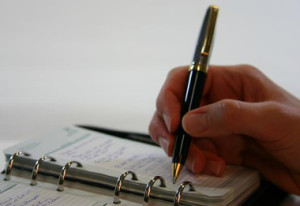I know in my own life, organization is a constant process of evolution. Both at home and work, I’m constantly striving for more efficient ways to stay organized. Does this combination help us to achieve greater balance and facilitate higher levels of achievement?? …I think so!
Here’s a great list of tips from ZenHabits.net for keeping your life organized…these can apply to both work and home environments. Balance!
27 Great Tips to Keep Your Life Organized
Every Monday is Productivity & Organization Day at Zen Habits.
It’s a rare person among us who doesn’t feel the need to get more organized. I consider myself fairly organized, for example, but there are times when I get a little lax about my organizational rules, and there’s always room for improvement.
And if you’re already organized (read: you’re an organizational freak), chances are, you like to read about others’ organizational systems.
As such, there should be something for everyone on this list.
A couple of weeks ago, I asked all of you for your best organizational tips and tools. And you responded in force, with some great stuff. What follows are some of the best of the tips (tools will be in another post), edited for brevity and consistency.
I must emphasize: these are not my tips, but yours, and when you see the word “I” it refers to the reader writing the tip, not me. Names have been removed to protect the innocent.
- 3 Most Important Tasks. Writing down and making mental note of my top 3 tasks to get done for the day. Everything else seems to fall into place if I do that.
- An easy and workable task list, or to do list. While I love all of these handy web 2.0 apps, computer software, very neat gadgets like palms and really cool cell phones, they just don’t work for me. I’m a lazy woman, with an even lazier attitude. I might put a task in Remember the Milk, another task in my palm, one in my Gcal and send another text to my phone. With all of these different ways of doing things, I end up spending much more time trying to organize my to do list, or consolidate it, that I don’t get much actually done.
- Keep ubiquitous capture device. It might not be the same device for every location (I have a moleskine for work, but use my mobile for inspiration on the fly) but just being able to write stuff down when you think about it is key for me.
- Choose one tool and stick with it.
- Do one thing at a time.
- Do it now.
- Make use of the word no.
- Use the recycling bin/trash basket. Organizing unnecessary items is wasted energy. It is amazing how much more in control I feel just by ridding myself of now outdated articles I’d like to read “someday,” or countless meeting notes from which relevant action items have already been extracted.
- A (good) place for everything, and everything in its place. By finding places that are easy to get to for all the things I use most often, and places that are pretty easy to get to for the things I use less often, I spend less time dreading doing things and more time actually doing things. And the place for things you never use is elsewhere (trash can, place that accepts donations, etc.).
- Simplify, simplify, simplify!
- Put it away now. The single, simplest thing I do to stay personally organized is to put whatever tool, item, clothing, bag, hairbrush etc., away immediately after using it. I always know where everything and anything is so I never waste time looking for something. Very efficient. I could tell a stranger where to find anything in my home.
- Keep a to-do list that syncs with your mobile phone (so you can add stuff as and when you remember it). And make sure every item has a due date.
- Change. It obsoletes unimportant things. It brings down any method or idea that isn’t timeless. It brings up newer and more important things that you and others can’t resist anymore. Best of all: it’s an organizing tool that operates itself. You simply have to embrace it.
- Divide material into red, yellow, blue and green plastic file folders. For example, anything that has to be done today (paperwork to be given to a client, bills to be mailed) go in the red folder. Contact material or anything related to customer field support goes in the yellow folder. Your mileage may vary as to how you organize your briefcase, and like me you may also have project-specific manilla file folders as well, but dividing stuff up into just four color coded folders is a huge help.
To continue reading the rest of these tips follow this link to the article in its entirety.
